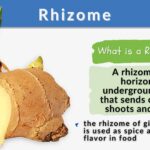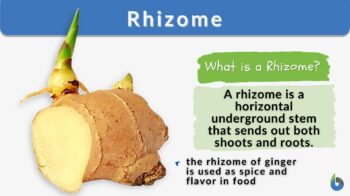
Rhizome
n., plural: rhizomes
[ˈɹaɪzoʊm]
Definition: a horizontal plant stem with shoots above and roots below
Table of Contents
The rhizome is derived from the Greek word rhizoma, meaning “a bunch of roots”. Usually, rhizomes are confused with roots; they may look like roots but they are actually modified and advanced plant stems.
Rhizome Definition
Rhizomes are stems positioned either horizontally or vertically under the ground with roots or shoots coming out from the nodes and surrounded by leaves (either scale-like, green leaves, or buds). They are stems and not roots because they have the fundamental features of a stem, such as the presence of internodes, small leaves, buds, and nodes.
They are, however, modified stems. By modified, it means that they are specialized for functions other than providing mechanical support. Rhizomes, in particular, are specialized for storing food. Thus, some of the rhizomes are cultivated to be harvested and used as sources of food for humans, e.g. turmeric and ginger.
What is a rhizome? Most biologists define the rhizome as a part of the plant. It is also known as rootstalk. However, it is a stem that creeps and grows horizontally under the ground and produces plant systems such as root and shoot of a new plant.
Rhizomes are specialized forms of stems that can produce new shoots and roots while staying underground. These rhizomes store proteins, nutrients, starches, and glucose to help plants survive unfavorable environmental conditions.
Types of Rhizomes
They are divided into two types: (1) dense and (2) running. Dense rhizomes grow vertically. They produce roots on the lower side while shoots grow upright from the nodes. They have short internodes. For instance, the ginger rhizome remains compacted and does not spread along the ground.
Conversely, the running rhizomes spread horizontally either underground, subterranean, or above the soil but are closely intact. These rhizomes extend both roots and shoots from the nodes. The internodes are longer than those of the dense rhizomes. For example, the rhizomes of bamboo grow and spread all over the garden rather than forming a single clump.
Characteristics of Rhizomes
- These adapted stems allow parent plants to produce offspring through asexual reproduction (vegetative propagation). For instance, bamboos, ginger, poplars, and other plants process vegetative propagation through rhizomes.
- Several water plants, including lilies or aquatic ferns, possess only a single stem (rhizome), showing flowers and leaves hiding the stem.
- Rhizomes are food providers that store starches underground in the case of turmeric, ginger, and lotus.
- These food-storing stems ensure the survival of plants in adverse conditions (winters).
- Rhizome plants such as potatoes gather energy in the form of starch or other sugars (glucose, sucrose, and fructose), and these rhizomes are thicker compared to stems growing above the ground.
- Rhizomes also protect perennial plants by providing them with energy throughout winter.
- The advanced stems tend to produce rapidly and spread all over the place due to weed characteristics.
Rhizome Function
Despite different characteristics, the rhizomes perform several primary and secondary functions that help plants for better growth.
Storage of nutrients
The main function of rhizomes is to store food for the plant to survive harsh weather conditions. These save all the nutrients from proteins to carbohydrates to other minerals.
Vegetative propagation
Another primary function that rhizomes perform is to utilize the stored nutrients and provide them to the plant during reproduction through vegetative propagation to ensure plants’ growth during winter. Watch the video below to learn how to grow a plant, such as bamboo, with a rhizome transplant.
Source of food
Besides providing energy to the plants through stored food, the rhizomes are a food source for humans, such as ginger and turmeric, as spice or seasoning enhances the taste.
Increases growth
According to the research on the rhizome structure and functions, the rhizomes’ apical parts tend to keep the energy stored for plant growth even during low temperatures. Thus, the rhizome’s rapid growth and metabolic functioning lead to plant growth even in winter, and therefore, perennial plants have more life spans by preserved vegetative underground meristems.
Rhizome Examples
As mentioned, many plants develop rhizomes, they can be classified based on their stem system. There are three basic types: (1) underground, (2) above-ground, and (3) multi-layered rhizomes.
Rhizomes: Underground stem system
These rhizomes are common and can be found growing underground. Also, many of them are consumed by humans. Examples of these rhizomes include bamboo, grass species, ginger, poison oak, and hops.
1. Bamboo Rhizomes
The bamboo rhizomes extend underground, containing both nodes and internodes. The new axillary buds appearing on the nodes produce more rhizomes or new bamboo shoots that grow further. The three types of bamboo rhizomes are; monopodial type (runner), mixpodial type, and sympodial type (clumper).
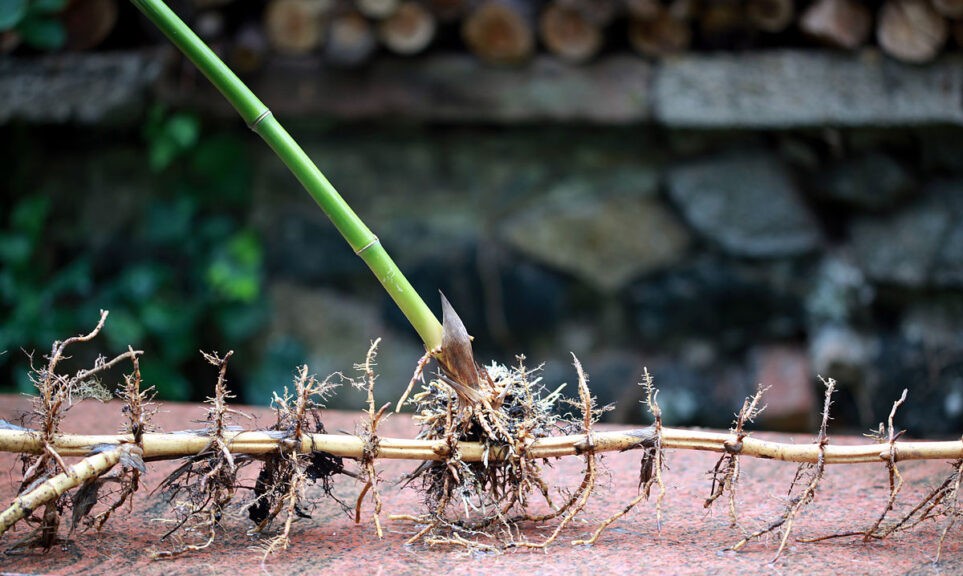
2. Ginger
The rhizomes of ginger are used as spice and flavor in food due to pungency and piquant characteristics. Also, it has been used as a medicine to improve health-related issues.
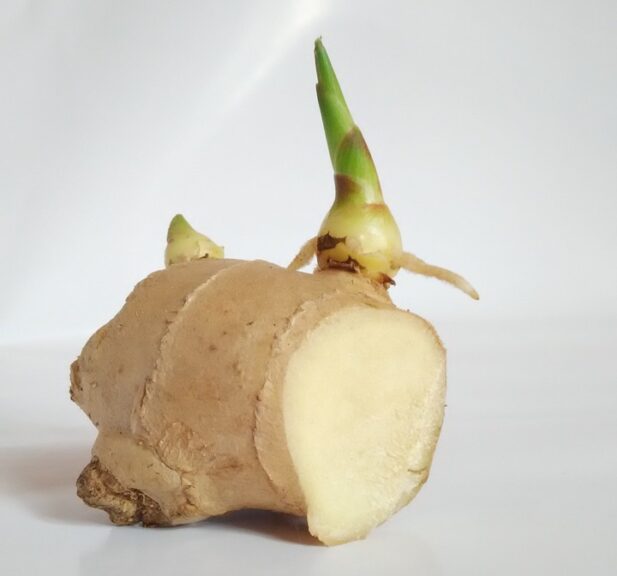
3. Poison oak
Poison oak is a shrub that spread all over the ground due to the rhizomes that continuously produce new shoots. The sap in the oak contains urushiol (a poisonous substance) that is extremely harmful.

Rhizomes: Above-ground stem system
As the name suggests, these rhizomes grow above the ground and close to the soil. These rhizomes extend shoots from the nodes, and a fully new plant can be grown through a single patch of the rhizome. Examples of such rhizomes include irises and ferns.
1. Iris
Horizontally rhizomes produce irises with bare roots, and the top parts remain uncovered. The rhizomes are creeping in dry climatic areas and contain basal leaves (usually sword-like).
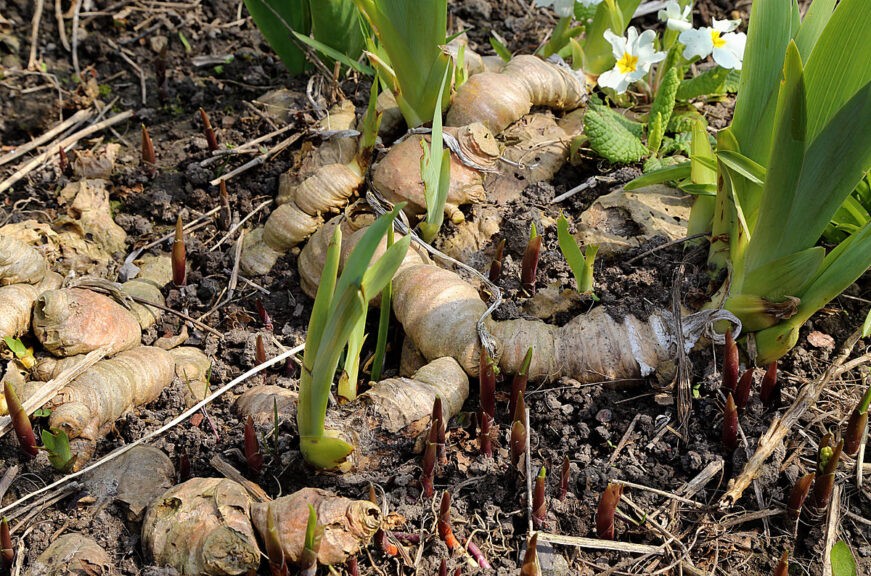
2. Ferns
Most ferns have rhizomes creeping close to the soil or substrate they live on and extend along the ground. The rhizomes are either short creeping (fragile fern) or extended creeping (licorice fern).
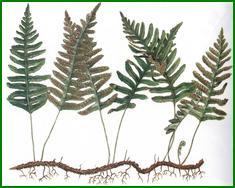
Rhizomes: Multi-layered stem system
A multi-layered stem system refers to the formation of both roots and shoots from the nodes in several layers, forming a complex-looking plant. Unlike other plants containing a single layer of roots and shoots, the multi-layered rhizomes have different layers and whorls of leaves. Example: Giant Horsetails.
Giant Horsetails
The horsetails from Latin America, North Africa, Mexico, Eurasia, North America, Central America, and South America are coined as giant horsetails. These horsetails’ rhizomes are upright, extending roots towards the ground, and contain multiple hollow leaves spreading from nodes and forms whorls.
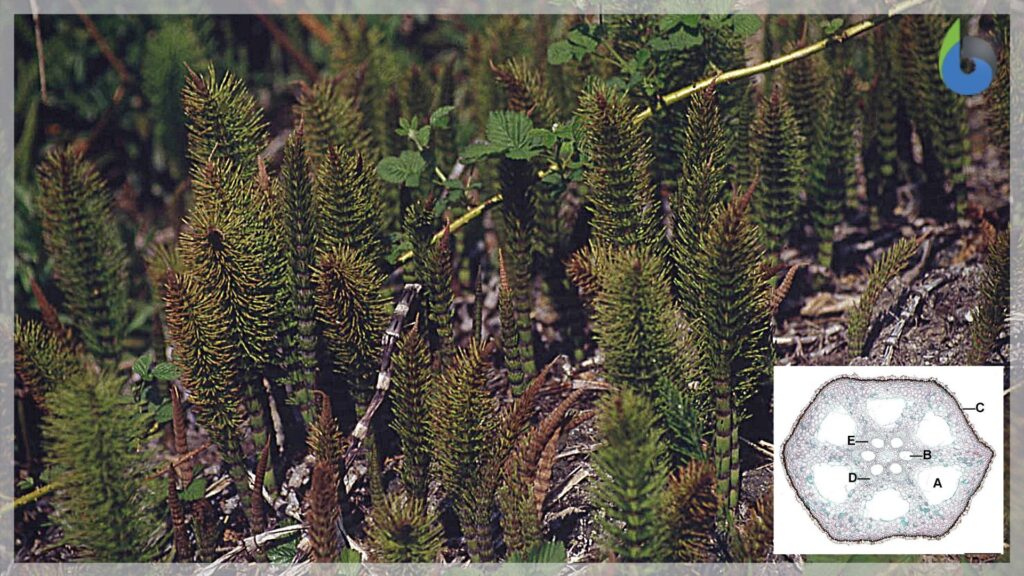
Differences Between Rhizoids, Roots, and Rhizomes
The 3 R’s (rhizoids, rhizomes, and roots) are quite similar in appearance context. However, on the distribution of functionality, these parts are distinguishable as the rhizomes are stems that are either underground or above, rhizoids are tiny extended structures, and roots are branching structures that extend underground. Roots and shoot systems arise from rhizomes, whereas roots absorb water and nutrients and are found in vascular plants. Rhizoids are found in nonvascular plants (bryophytes and algae).
| Rhizoids | Roots | Rhizomes |
|---|---|---|
|
|
|
Comparison between Rhizomes, Bulb, Stolon, and Corm
Rhizomes are just one of the many types of modified stems. Other modified stems are bulbs, stolons, and corms. However, each has distinct features. Below is the table that compares one to the other.
| Rhizomes | Bulb | Stolon | Corm |
|---|---|---|---|
|
|
|
|
Try to answer the quiz below to check what you have learned so far about rhizomes.
Further Reading
References
- Fox, Mark, Linda E. Tackaberry, Pascal Drouin, & Han Chen (2013). “Microbial community structure of soils under four productivity classes of aspen forests in Northern British Columbia.” Ecoscience 20(3):264–275. doi:10.2980/20-3-3611
- Rayirath, Usha P.; et al. (2011). “Role of ethylene and jasmonic acid on rhizome induction and growth in rhubarb (Rheum rhabarbarum L.).” Plant Cell Tissue Organ Culture. 105 (2): 253–263. doi:10.1007/s11240-010-9861-y
- Svetlana, M. Ruslan, M. (2016). STRUCTURE AND FUNCTIONS OF RHIZOMES OF MENTHA ARVENSIS (LAMIACEAE). Botanicheskiy Zhurnal. 101(10):1201-1212
- John, K., Hartog., (2001). Seagrass taxonomy and identification key. Global Seagrass Research Methods. 31-58. doi:10.1016/B978-044450891-1/50003-7.
©BiologyOnline.com Content provided and moderated by Biology Online Editors.



